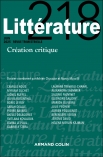
Romantisme n°187 (1/2020)
Pour acheter ce numéro, contactez-nous
Recevez les numéros de l'année en cours et accédez à l'intégralité des articles en ligne.
Cet article examine la façon dont, au cours de la seconde moitié du XIXe siècle surtout, une série de dispositifs optiques (camera obscura, miroir, photographie) et la technique du portrait ont pris au piège tour à tour l’âme, l’esprit et le regard. En effet, pour un grand nombre de personnes (« sauvages », habitants de contrées reculées, ignorants, incultes et nomades), ces instruments d’optique et les portraits réalisés avec ont constitué un réel danger de mort, leur âme leur étant arrachée pour être mise en image. Par-delà le côté amusé ou railleur des anecdotes rapportant ces faits, on perçoit la véritable stratégie idéologique qui consistait à portraiturer toutes ces personnes. Prendre leur portrait était une manière de prendre leurs âme, identité et personnalité pour les aliéner et les faire entrer de force dans la modernité de la civilisation industrielle et capitaliste.
This paper examines the way, especially during the second half of the 19th century, a series of optical mechanisms ( camera oscura, mirror, photography) and the technique of the portrait in turn caught in their nets the soul, the spirit and the gaze. For a large number of people (« savages », the inhabitants of far-off places, the ignorant, the unstudied, nomads), these instruments and the portraits they enabled really represented a mortal danger, that of their soul being ripped away from them to be put into a picture. Beyond the amused or mocking tone of the anecdotes recounting such facts, the real ideological strategy consisting in having a portrait of all these people can be perceived. Taking their portrait was a way of taking their souls, identities and personalities, alienating them and forcing them into the modernity of industrial and capitalist civilisation.

